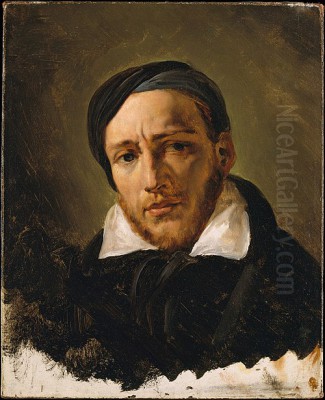
Jean-Louis André Théodore Géricault, born on September 26, 1791, in Rouen, France, and tragically passing away on January 26, 1824, in Paris, stands as a monumental figure in the annals of art history. Though his career spanned little more than a decade, Géricault became a principal pioneer of the Romantic movement in French painting. Emerging from a wealthy background, he possessed the financial freedom to pursue his artistic passions, yet he channeled this privilege into creating works of startling power, emotional depth, and often unsettling realism, forever altering the course of European art. His legacy is defined by a dramatic intensity, a fascination with the extremes of human experience, and an iconic masterpiece, The Raft of the Medusa.
Early Life and Artistic Formation
Born into prosperity, Géricault's family moved to Paris during his childhood, providing him access to the heart of the French art world. His innate talent and passion for drawing, particularly his fascination with horses, were evident early on. Supported by his family's wealth, he initially sought formal training around 1808 under Carle Vernet. Vernet, himself a noted painter known for his depictions of horses and battle scenes, perhaps seemed a natural fit. However, the young Géricault quickly grew restless, finding Vernet's approach perhaps too superficial or conventional for his burgeoning, intense vision.
Seeking a more rigorous grounding, Géricault entered the studio of Pierre-Narcisse Guérin in approximately 1810. Guérin was a respected Neoclassical painter, a follower of the dominant style championed by Jacques-Louis David. While Guérin provided a more structured academic environment, Géricault's temperament chafed against the strictures and idealized forms of Neoclassicism. It was in Guérin's studio, however, that he formed a crucial and lasting friendship with a younger student, Eugène Delacroix, who would become the leading figure of French Romanticism after Géricault's death.
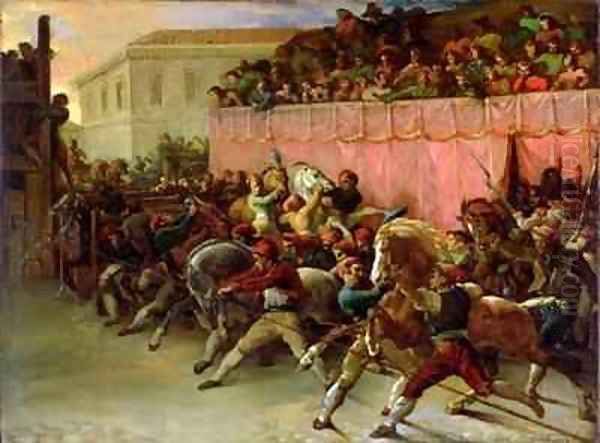
Despite his formal apprenticeships, much of Géricault's most formative education was self-directed. Between 1811 and 1814, he immersed himself in the Louvre, diligently copying the works of Old Masters. This practice was essential to his development. He gravitated towards the dynamism and rich colour of Baroque masters like Peter Paul Rubens, the dramatic intensity and realism of Spanish painters like Diego Velázquez, and the profound humanity found in the works of Rembrandt. He also studied the powerful forms of Renaissance giants like Michelangelo and the dramatic lighting of Caravaggio, absorbing lessons in composition, anatomy, and emotional expression that would profoundly shape his unique style.
Breaking Ground: Early Salon Success
Géricault announced his arrival on the Parisian art scene with dramatic flair at the Salon of 1812. His submission, The Charging Chasseur (full title: Officer of the Imperial Guard Charging), was a bold statement. Depicting a mounted officer twisting dynamically on his rearing horse against a smoky, turbulent background, the painting captured the energy and uncertainty of the Napoleonic era. It was a departure from the static, posed quality often found in Neoclassical military portraits, favouring movement and psychological intensity over idealized heroism. The work earned him a gold medal and marked him as a significant new talent.
Two years later, at the Salon of 1814, coinciding with the initial fall of Napoleon, Géricault presented a companion piece, The Wounded Cuirassier Leaving the Field. This painting offered a stark contrast to the heroic charge of the earlier work. Here, a dismounted, injured soldier leads his horse away from battle, his expression conveying defeat and exhaustion. Together, these two paintings demonstrated Géricault's ability to capture both the glory and the grim reality of contemporary conflict, moving beyond Neoclassical allegory to engage directly with the lived experiences of his time. His fascination with the horse, not merely as an accessory but as a powerful, expressive creature, was already evident. These early successes established his reputation but also hinted at his inclination towards dramatic, emotionally charged subjects drawn from modern life.
Italian Interlude: Renaissance and Realism
Seeking further artistic development and perhaps escaping personal entanglements in Paris, Géricault travelled to Italy in 1816, staying for about a year, primarily in Florence and Rome. This journey was profoundly influential. He immersed himself in the art of the Italian Renaissance, particularly the works of Michelangelo, whose mastery of the human form and powerful, muscular figures left a lasting impression. He was also drawn to the raw energy of Roman life, including the popular horse races.
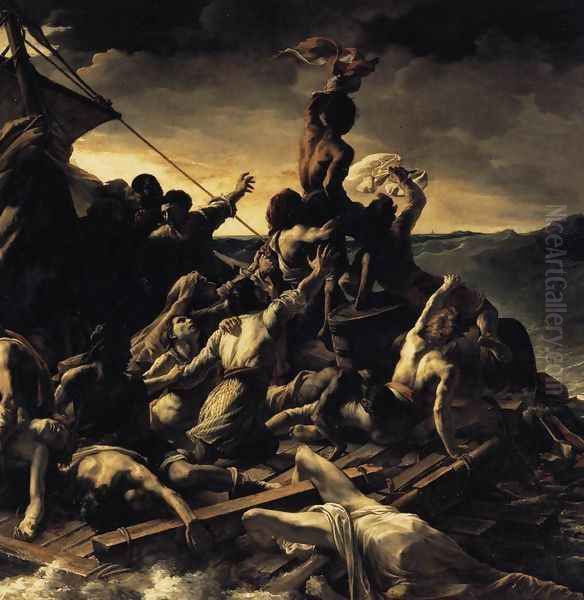
His experiences in Italy fueled his creativity. He sketched prolifically, studying classical sculptures and Renaissance masterpieces. One notable work from this period is The Riderless Racers at Rome (c. 1817). This painting captures the chaotic energy of the traditional Barberi horse race, focusing on the struggle between the grooms and the untamed horses at the start. The dynamic composition, the emphasis on muscular forms (both human and equine), and the raw energy conveyed reflect both his study of classical art and his direct observation of contemporary life. The Italian sojourn deepened his understanding of anatomy, composition, and the potential for art to convey intense physical and emotional states, directly feeding into the monumental work he would undertake upon his return to France.
The Raft of the Medusa: A Monument of Suffering
Upon returning to Paris in late 1817, Géricault sought a subject of epic scale and contemporary relevance that would solidify his reputation. He found it in the sensational and scandalous shipwreck of the French naval frigate Méduse off the coast of West Africa in 1816. Due to the incompetence of the politically appointed captain, the ship foundered. While the captain and senior officers escaped in lifeboats, over 150 people were set adrift on a hastily constructed raft with minimal supplies. What followed was a horrific ordeal of starvation, dehydration, mutiny, murder, and cannibalism. After 13 days, only 15 men were rescued (five died shortly after). The event became a major political scandal, highlighting the corruption and ineptitude of the restored Bourbon monarchy.
Géricault threw himself into the project with obsessive dedication between 1818 and 1819. He meticulously researched the event, interviewing survivors, including the ship's surgeon Henri Savigny and engineer Alexandre Corréard. He studied corpses and severed limbs in hospital morgues to accurately depict the pallor and anatomy of the dead and dying, creating numerous gruesome preparatory sketches known as his anatomical fragments. He even commissioned a scale model of the raft to be built in his studio and had his friend, Eugène Delacroix, pose for one of the figures (specifically, the figure lying face down with arm outstretched in the foreground).
The resulting painting, The Raft of the Medusa, unveiled at the Salon of 1819, is a harrowing masterpiece of Romanticism. Measuring an immense 4.91 by 7.16 meters (16 ft 1 in × 23 ft 6 in), it confronts the viewer with the raw horror of the survivors' plight. Géricault chose the moment when the survivors spot a rescue ship (the Argus) on the horizon, creating a dramatic pyramid of figures surging towards this faint glimmer of hope, contrasting with the dead and dying in the foreground. The composition is dynamic and unstable, reflecting the precariousness of the raft and the emotional turmoil. The lighting is dramatic, employing chiaroscuro reminiscent of Caravaggio to highlight the gaunt bodies and desperate expressions. The realism is unflinching, depicting suffering and death without Neoclassical idealization.
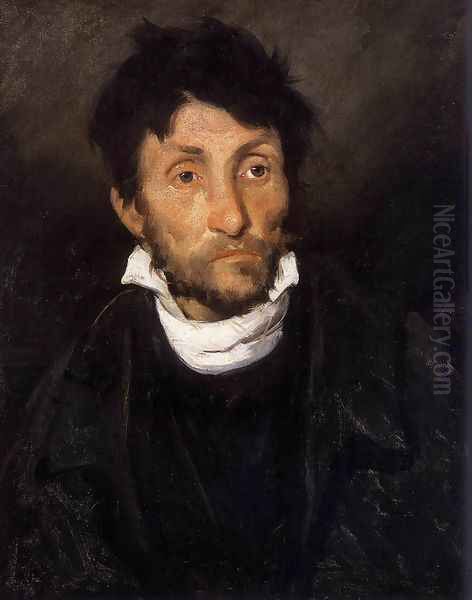
The painting caused an immediate sensation and provoked intense debate. It was praised for its artistic power but criticized for its gruesome subject matter and its implicit political critique of the monarchy. It defied Neoclassical conventions of noble themes and idealized forms, instead presenting a contemporary tragedy with brutal honesty. Despite the controversy, the French state eventually purchased the painting (though initially for a modest sum). The Raft of the Medusa remains Géricault's most famous work, an icon of Romantic art that powerfully embodies themes of suffering, hope, survival, and social commentary.
Explorations in England and Later Life
Following the exhibition of The Raft of the Medusa, Géricault travelled to England in 1820, staying for nearly two years. He was drawn partly by the opportunity to exhibit his masterpiece there, where it achieved considerable success, and partly by his Anglophilia, particularly his admiration for English sporting art and contemporary life. During his time in London, he produced a remarkable series of lithographs depicting the city's social fabric, from scenes of poverty and labour in works like Pity the Sorrows of a Poor Old Man to the dynamism of the Epsom Derby. These lithographs showcased his keen observational skills and his growing interest in social realism. While in England, he likely encountered the works of landscape painters like John Constable and J.M.W. Turner, though the direct influence on his own work is debated.
Upon his return to France in late 1821, Géricault's health was beginning to decline, possibly exacerbated by riding accidents and perhaps tuberculosis or another chronic illness. Yet, he embarked on one of his most intriguing projects: a series of portraits of the mentally ill, known as the Monomaniacs. Commissioned by Dr. Étienne-Jean Georget, a pioneering psychiatrist at the Salpêtrière hospital in Paris, these ten portraits (of which five survive) depicted patients believed to be suffering from specific obsessions or "monomanias" (e.g., the Kleptomaniac, the Woman Addicted to Gambling). Painted with remarkable empathy and psychological insight, these works are unique for their time, treating the subjects not as mere clinical specimens but as individuals, capturing their inner turmoil with startling directness and realism. They stand as powerful testaments to Géricault's interest in the extremes of the human condition.
The Passion for Horses
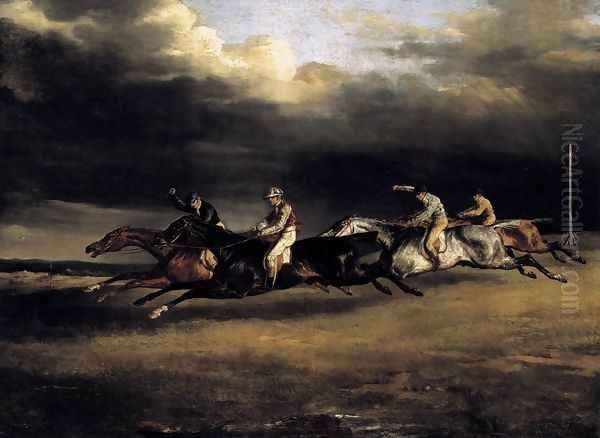
Throughout his short life, the horse remained a constant and defining passion for Géricault. This fascination began in childhood and permeated his artistic output, far exceeding the conventional use of horses in historical or military painting. His early training with Carle Vernet, a specialist in equine subjects, provided a foundation, but Géricault's depictions possessed a unique energy and psychological depth. He didn't just paint horses; he seemed to understand their spirit, anatomy, and movement with an almost visceral connection.
From his early Charging Chasseur to the chaotic energy of the Riderless Racers at Rome, horses were central to some of his most dynamic compositions. He produced numerous studies, sketches, paintings, and lithographs dedicated to the subject: horses in stables, horses racing at Epsom Downs, military steeds, dray horses working on the streets of London. He captured their power, grace, and vulnerability. This lifelong obsession, however, also contributed to his demise. A keen horseman, Géricault suffered several serious riding accidents, which likely aggravated underlying health problems and hastened his early death. The horse was both his muse and, indirectly, a factor in his tragic end.
Géricault's Distinctive Style
Théodore Géricault forged a style that was revolutionary for its time, marking a decisive break from the prevailing Neoclassicism of David and his followers like Guérin and Jean-Auguste-Dominique Ingres. His art is fundamentally Romantic in its emphasis on emotion, drama, individualism, and the sublime – particularly the terrifying aspects of nature and human experience. He drew heavily on the Baroque tradition, emulating the dynamic compositions, rich colours, and dramatic use of light and shadow (chiaroscuro) found in the works of Rubens and Caravaggio.
Unlike the smooth finish and linear precision favoured by Neoclassicists, Géricault often employed energetic, visible brushwork, building up form and texture with a palpable sense of urgency. His colour palette could be dramatic and sometimes somber, used to heighten emotional impact. He tackled contemporary subjects, often controversial or unsettling ones, with a realism that stripped away idealization, confronting viewers with the raw facts of suffering, death, or psychological distress. His mastery of anatomy, honed through intense study (including corpses), allowed him to depict the human and animal form with convincing power and physicality. His compositions are often dynamic, using diagonals and swirling movements to create tension and energy, perfectly suited to his dramatic themes.
A Life of Intensity and Contradiction

Géricault's art reflects his personality: passionate, intense, and perhaps tormented. His privileged background afforded him independence, but he seemed driven by an inner restlessness and a fascination with struggle and extremes. His obsessive dedication to The Raft of the Medusa, including his self-imposed isolation and morbid research, speaks to an all-consuming artistic drive. Friends noted his fluctuating moods, and he likely suffered from periods of depression.
His personal life also contained elements of turmoil and secrecy. He engaged in a controversial and clandestine affair with Alexandrine-Modeste Caruel, the young wife of his maternal uncle, which resulted in the birth of a son in 1818. This relationship caused considerable personal distress and likely contributed to his decision to travel to Italy. His passion for horses and risky pursuits like riding further underscore a life lived with intensity. He died at the young age of 32, his body weakened by chronic illness and injuries from riding accidents, leaving behind a relatively small but incredibly potent body of work.
Enduring Legacy and Influence
Despite his tragically short career, Théodore Géricault's impact on the course of art history was profound and lasting. He is rightly considered a foundational figure of French Romanticism, paving the way for the movement's full flowering under his friend and admirer, Eugène Delacroix. Delacroix openly acknowledged Géricault's influence, and the dramatic intensity, rich colour, and emotional depth of Géricault's work resonated deeply within the Romantic sensibility. The Raft of the Medusa, in particular, became a touchstone for subsequent generations.
Géricault's influence extended beyond Romanticism. His commitment to depicting contemporary events with unflinching realism, his interest in social commentary, and his focus on the lives of ordinary people (and even the marginalized, as seen in the Monomaniacs) anticipated the rise of Realism later in the century, influencing artists like Gustave Courbet. His bold brushwork and expressive style also contained seeds that would later germinate in Impressionism and Expressionism. Artists like Édouard Manet admired his modernity and powerful compositions. Even contemporaries working in different styles, like the military and genre painter Horace Vernet (son of his first teacher, Carle), operated within the artistic landscape Géricault helped reshape. He demonstrated that art could be immediate, visceral, and deeply engaged with the complexities and traumas of modern life, moving decisively away from the idealized historical and mythological subjects of the Neoclassical tradition.
Conclusion
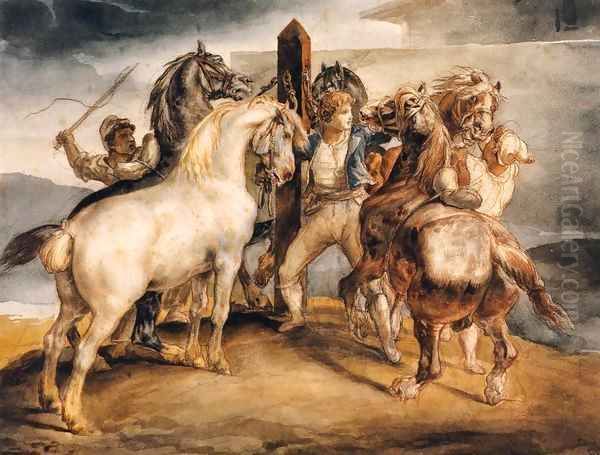
Théodore Géricault's life was brief, but his artistic vision was powerful and transformative. In little more than a decade, he produced works that challenged artistic conventions, explored the extremes of human experience, and captured the turbulent spirit of his age. From the dynamic energy of his equestrian paintings to the harrowing realism of The Raft of the Medusa and the poignant empathy of the Monomaniacs, his art pulses with an intensity and honesty that continues to resonate. As a crucial pioneer of Romanticism and a precursor to Realism, Géricault irrevocably changed the direction of French and European art, leaving behind a legacy defined by passion, power, and profound humanity.